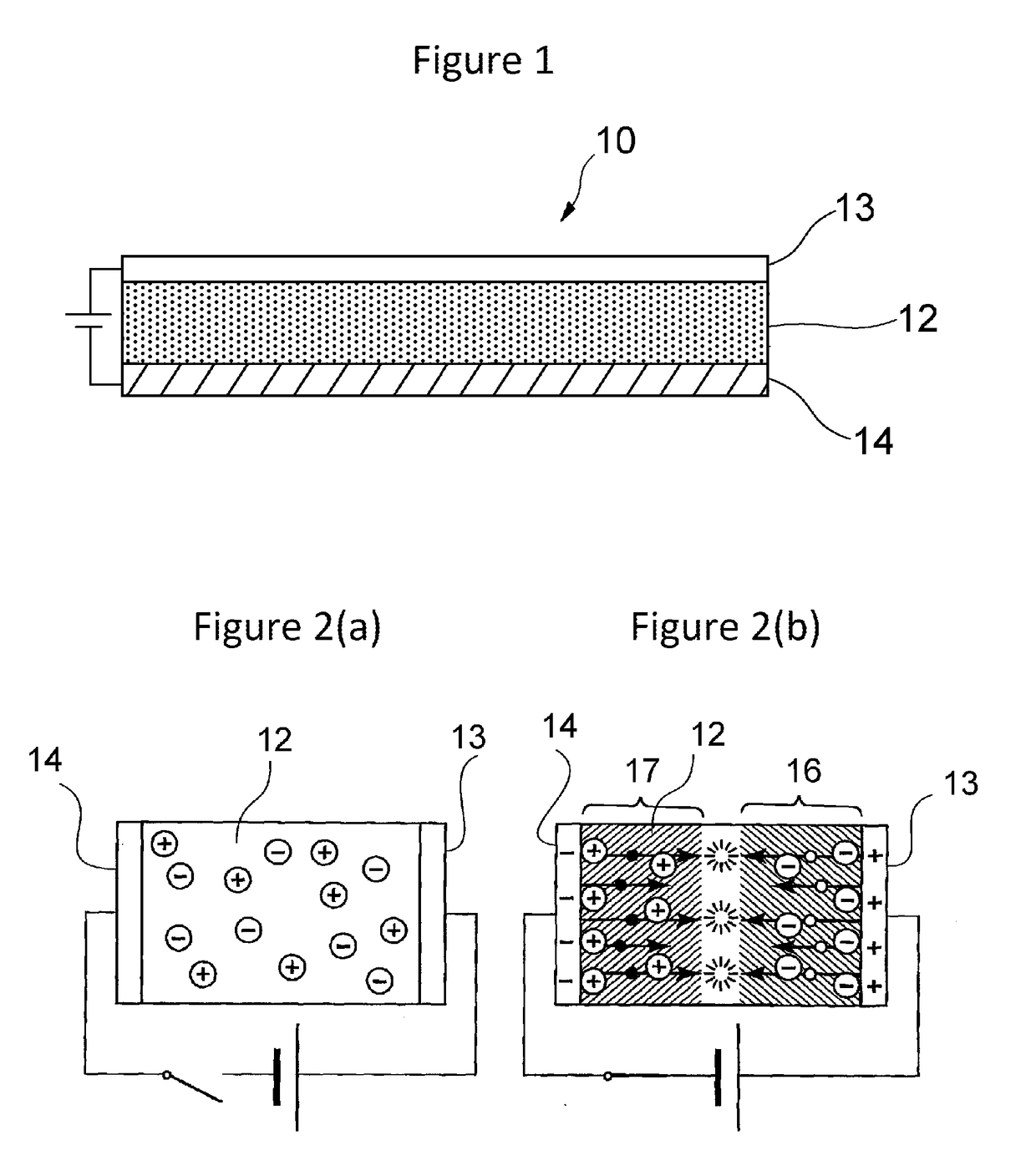Additive for light-emitting layer in light-emitting electrochemical cell, composition for forming light-emitting layer in light-emitting electrochemical cell, and light-emitting electrochemical cell
a technology of electrochemical cell and additive, which is applied in the direction of group 3/13 element organic compounds, group 5/15 element organic compounds, etc., can solve the problems of increasing the number of production processes, complex structure, and many restrictions of organic el devices, and achieve excellent emission luminance, high luminous efficiency, and high luminous efficiency
- Summary
- Abstract
- Description
- Claims
- Application Information
AI Technical Summary
Benefits of technology
Problems solved by technology
Method used
Image
Examples
example 1
[0112]A commercially available glass substrate with an ITO film (manufactured by Geomatec Co., Ltd., ITO film thickness: 200 nm) was used as a first electrode 13.
[0113]There were used PFO-spiro (poly[(9,9-dioctylfluorenyl-2,7-diyl)-alt-co-(9,9′-spirobifluorene-2,7-diyl)], manufactured by Solaris Chem Inc., model number: SOL2412) as an organic polymeric light-emitting material, a phosphonium phosphate salt indicated in Table 1 as an ionic compound, and an additive being a compound indicated in Table 1; and a mixed solution of these was prepared. Specifically, in a glove box in an argon atmosphere at room temperature, a toluene solution (concentration: 9 g / L) of the organic polymeric light-emitting material, a toluene solution (concentration: 9 g / L) of the ionic compound, and a toluene solution (concentration: 9 g / L) of the additive were mixed in the solution of the organic polymeric light-emitting material:the solution of the ionic compound; the solution of the additive=8:1:1 in volu...
example 2-1 to 2-5
[0117]A commercially available glass substrate with an ITO film (manufactured by Geomatec Co., Ltd., ITO film thickness: 200 nm) was used as a first electrode 13.
[0118]There were used Super Yellow (phenylene-substituted poly(para-phenylene vinylene), manufactured by Merck KGaA, product name: PDY-132) as an organic polymeric light-emitting material, a phosphonium phosphate salt indicated in Table 2 as an ionic compound, and an additive being a compound indicated in Table 2; and a mixed solution of these was prepared. Specifically, in a glove box in an argon atmosphere at room temperature, a toluene solution (concentration: 9 g / L) of the organic polymeric light-emitting material, a toluene solution (concentration: 9 g / L) of the ionic compound, and a toluene solution (concentration: 9 g / L) of the additive were mixed in the solution of the organic polymeric light-emitting material:the solution of the ionic compound; the solution of the additive=8:1:1 in volume ratio to thereby prepare a...
example 3
[0122]A light-emitting electrochemical cell 10 was fabricated by the same method as in Example 1, except for using an ammonium phosphate salt indicated in Table 3 as an ionic compound. The result of a measurement of the luminous property of the obtained light-emitting electrochemical cell 10 is shown in Table 3.
PUM
| Property | Measurement | Unit |
|---|---|---|
| Percent by mass | aaaaa | aaaaa |
| Percent by mass | aaaaa | aaaaa |
| Percent by mass | aaaaa | aaaaa |
Abstract
Description
Claims
Application Information
 Login to View More
Login to View More - R&D
- Intellectual Property
- Life Sciences
- Materials
- Tech Scout
- Unparalleled Data Quality
- Higher Quality Content
- 60% Fewer Hallucinations
Browse by: Latest US Patents, China's latest patents, Technical Efficacy Thesaurus, Application Domain, Technology Topic, Popular Technical Reports.
© 2025 PatSnap. All rights reserved.Legal|Privacy policy|Modern Slavery Act Transparency Statement|Sitemap|About US| Contact US: help@patsnap.com



